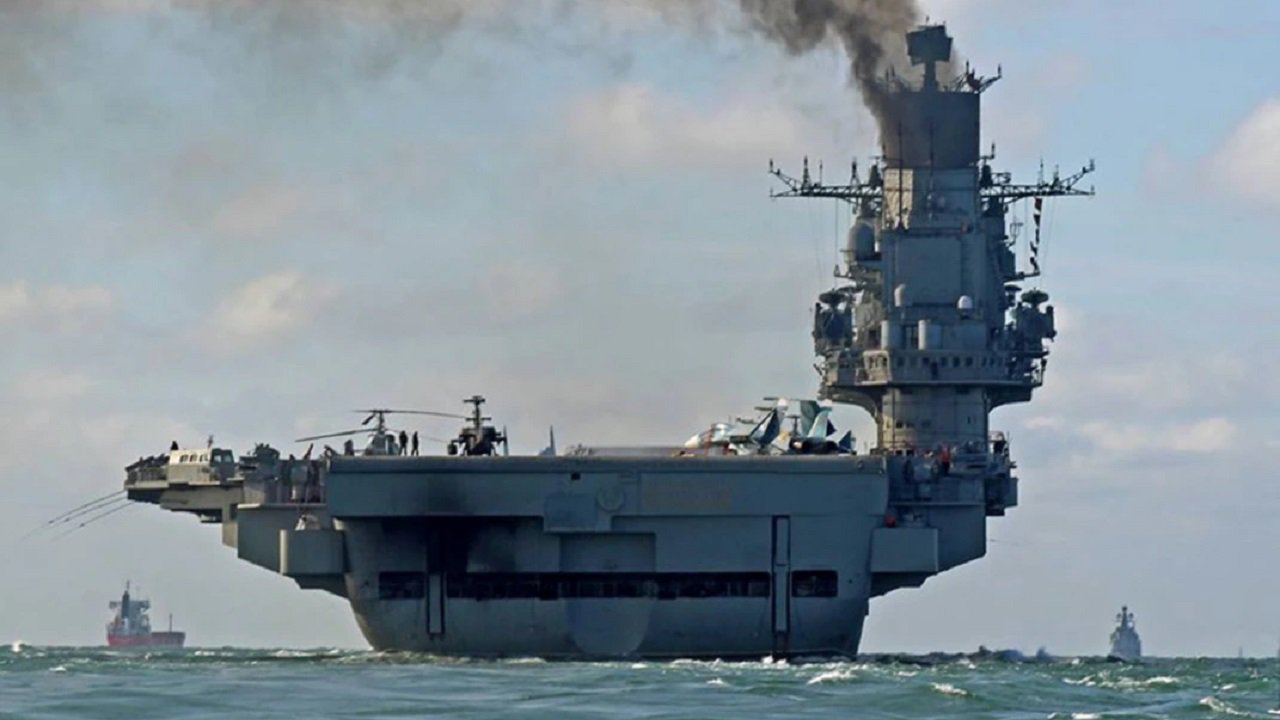Admiral Kuznetsov: Russia's Only Aircraft Carrier 'Is Badly Compromised'
Russia’s sole aircraft carrier, Admiral Kuznetsov, continues to be a significant disappointment for the Russian Navy. Designed to run on mazut, a dirty and cheap fuel known for its black smoke emissions and high pollution, the carrier’s propulsion system has been a long-standing issue.
Summary and Key Points: Russia’s sole aircraft carrier, Admiral Kuznetsov, continues to be a significant disappointment for the Russian Navy. Designed to run on mazut, a dirty and cheap fuel known for its black smoke emissions and high pollution, the carrier’s propulsion system has been a long-standing issue.
-Despite a costly refit aimed at replacing the main boilers, gas turbines, and other key systems, Kuznetsov remains in dry dock with its future uncertain.
-The ship’s inefficient fuel, environmental hazards, and incomplete upgrades make its return to operational status unlikely, casting doubt on its strategic value for Russia.
Russia’s Admiral Kuznetsov: A Wasting Asset or Sinking Investment?
Russia’s only aircraft carrier, Admiral Kuznetsov, continues to disappoint Russian naval strategists. It was last seen at sea in 2018, being towed by a tugboat. Since that time, it has been at the shipyards for a refit. But most experts think the refit will fail to make the carrier worthwhile.
The Russian Navy knows Admiral Kuznetsov is a wasting asset. Yet Moscow continues to throw money at it.
One of the key changes during the refit reportedly involves the ship’s propulsion system.
Kuznetsov uses gas turbines rather than nuclear power. A gas turbine usually runs on lighter, cleaner fuels. Instead, the Russians purposely designed Admiral Kuznetsov to utilize a dirty, cheap fuel source known as mazut.
What is Mazut?
Mazut has a high sulfur content that is known for billowing black smoke emissions. This is one of the dirtiest fuels in the world. It is a significant pollutant and causes grave harm to the respiratory systems of people who breathe it, including the sailors aboard Admiral Kuznetsov.
Particulates spewed from Admiral Kuznetsov’s mazut-fueled gas turbine propulsion system include sulfur dioxide, nitrogen oxides, and other, lesser-known pollutants.
Admiral Kuznetsov’s mazut-fueled engines also pollute the surrounding sea. The carrier was known for leaving large oil slicks in its wake that would linger and poison the surrounding aquatic environment for months after its transit.
The Barents Observer noted in 2020 that Admiral Kuznetsov’s “engines were old, and the black smoke was caused by incomplete combustion of [mazut] and engine lubricant.”
A Strategic Vulnerability for Russia
Having a large, billowing, easily identifiable smoke plume trailing your warship and leaving oil slicks in its wake is probably not the most strategically sound thing to do. With Moscow being so obviously committed to maintaining Admiral Kuznetsov against all reason, the Russians understand they need to address this obvious vulnerability.
That is why, according to TASS, Russia included “replacements of the main boilers, turbo-gear units, gas turbine, diesel generators, and the propeller auxiliary systems.”
Whether these changes will work or not remains to be seen. The propulsion system upgrades were supposed to be completed in 2020, with Moscow intending to test the warship by 2022.
Obviously, this never happened. Admiral Kuznetsov remains ensconced at the Naval Yard No. 35 slip in Murmansk.
A Hot Mess for the Russian Navy
Because the warship was a product of the late-stage Soviet Union, it sat incomplete for many years after the USSR collapsed. By the time it was finally completed, it was a hodgepodge of barely compatible systems.

The quality of the craftsmanship for the different phases of development also varied, since some of the ship was built when the Soviets had money and resources, and other parts of the carrier were finished under the auspices of budget-limited post-Soviet Russia.
It's no surprise, then, that the ship’s engine ran on such a cheap, inefficient, and dirty fuel as mazut. What’s more surprising is that the Russians waited decades to address the propulsion system woes.
The Russians seem to have waited too long. The integrity of the entire warship had been so badly compromised that it is highly unlikely she will hit the high seas ever again.
Author Experience and Expertise: Brandon J. Weichert
Brandon J. Weichert, a National Interest national security analyst, is a former Congressional staffer and geopolitical analyst who is a contributor at The Washington Times, the Asia Times, and The-Pipeline. He is the author of Winning Space: How America Remains a Superpower, Biohacked: China’s Race to Control Life, and The Shadow War: Iran’s Quest for Supremacy. His next book, A Disaster of Our Own Making: How the West Lost Ukraine, is due October 22 from Encounter Books. Weichert can be followed via Twitter @WeTheBrandon.
All images are Creative Commons or Shutterstock. All photos are of various submarine styles.
From the Vault
Russia Freaked Out: Why the U.S. Navy 'Unretired' the Iowa-Class Battleships
Battleship vs. Battlecruiser: Iowa-Class vs. Russia's Kirov-Class (Who Wins?)


